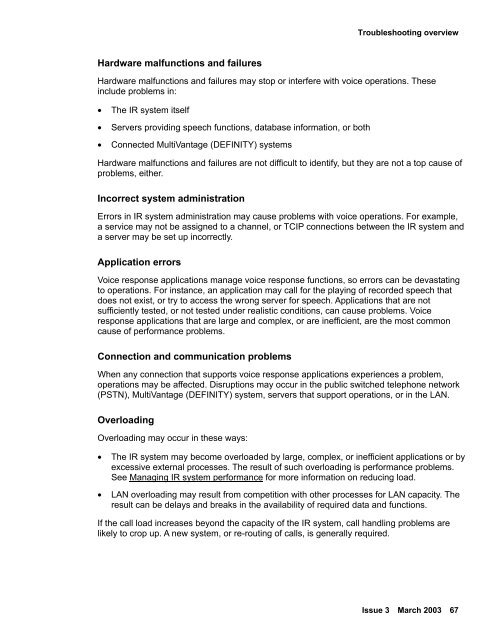Avaya IR Install and Troubleshooting Guide - Avaya Support
Avaya IR Install and Troubleshooting Guide - Avaya Support
Avaya IR Install and Troubleshooting Guide - Avaya Support
You also want an ePaper? Increase the reach of your titles
YUMPU automatically turns print PDFs into web optimized ePapers that Google loves.
<strong>Troubleshooting</strong> overviewHardware malfunctions <strong>and</strong> failuresHardware malfunctions <strong>and</strong> failures may stop or interfere with voice operations. Theseinclude problems in:• The <strong>IR</strong> system itself• Servers providing speech functions, database information, or both• Connected MultiVantage (DEFINITY) systemsHardware malfunctions <strong>and</strong> failures are not difficult to identify, but they are not a top cause ofproblems, either.Incorrect system administrationErrors in <strong>IR</strong> system administration may cause problems with voice operations. For example,a service may not be assigned to a channel, or TCIP connections between the <strong>IR</strong> system <strong>and</strong>a server may be set up incorrectly.Application errorsVoice response applications manage voice response functions, so errors can be devastatingto operations. For instance, an application may call for the playing of recorded speech thatdoes not exist, or try to access the wrong server for speech. Applications that are notsufficiently tested, or not tested under realistic conditions, can cause problems. Voiceresponse applications that are large <strong>and</strong> complex, or are inefficient, are the most commoncause of performance problems.Connection <strong>and</strong> communication problemsWhen any connection that supports voice response applications experiences a problem,operations may be affected. Disruptions may occur in the public switched telephone network(PSTN), MultiVantage (DEFINITY) system, servers that support operations, or in the LAN.OverloadingOverloading may occur in these ways:• The <strong>IR</strong> system may become overloaded by large, complex, or inefficient applications or byexcessive external processes. The result of such overloading is performance problems.See Managing <strong>IR</strong> system performance for more information on reducing load.• LAN overloading may result from competition with other processes for LAN capacity. Theresult can be delays <strong>and</strong> breaks in the availability of required data <strong>and</strong> functions.If the call load increases beyond the capacity of the <strong>IR</strong> system, call h<strong>and</strong>ling problems arelikely to crop up. A new system, or re-routing of calls, is generally required.Issue 3 March 2003 67
















